Arguments over Northwest coal exports have been hot and heavy in 2011. As one might expect, there’s been plenty of disagreement about values, but there’s also been quite a bit of disagreement over facts. After nearly a year of wrangling, here’s my attempt to establish a few foundational and un-contestable basics about coal export dynamics. Even if we disagree, we can at least argue from a common view of reality.
So here’s a fact: the US currently exports about 80 million tons of coal per year, including both thermal coal and metallurgical coal. That figure was sometimes higher during the 1980s and 1990s, but it’s been even lower in recent years.
In other words, plans for Northwest coal exports—moving 60 million tons from Longview, Washington plus 50 million tons from Bellingham, Washington—would more than double the existing total volume of US coal exports.
Here’s another fact: only a fraction of US coal exports go to Asia.
The biggest destination by far is Europe (orange line). Brazil is also a major importer (blue line). Yet imports to Asia are not insignificant. In addition to Japan (dark red line), exports to Asia account for some share of the “other” category (purple line). They also account for some of the exports to Canada (green line), which transships some US coal to market in Asia. [Author’s note: I was unable to find more detailed country-level export data at the EIA website. If it exists, please send it to me.]
Who are the biggest coal importers on earth? Taken together, the nations of Europe are the biggest importer by a hair. But Asian countries buy nearly two-thirds of all the world’s imported coal.
Among Asian countries, more than 90 percent of all coal imported flows to just five countries—Japan, China, South Korea, India, and Taiwan–while smaller amounts are purchased by countries like Malaysia, Thailand, the Philippines, and Hong Kong.
By any reckoning, the 110 million tons planned for Northwest ports would represent a very sizeable contribution to internationally traded coal in Asia. It’s more coal, in fact, than is imported annually by India.
And who are the biggest global coal exporters? Australia and Indonesia by a landslide, where coal exports have shot up recently far beyond levels projected just a few years ago.
Even at current levels—roughly 80 million tons per year—the US is already a major player in global coal exports, the fourth biggest by volume. Yet the exports planned for the Northwest would launch the country into the big leagues, which means that the decisions at Northwest ports have global significance.
Here’s another fact: the United States is sitting on a lot more coal than any other country on earth.
In fact, the US owns more than one-fourth of the entire planet’s recoverable coal, far more than the next biggest coal countries: Russia, China, Australia, and India. To a very large extent then, what the US decides to do with its coal is what the world will do about coal.
Yet the biggest consumer of coal is China by far, which is burning 3.7 billion tons per year, nearly half of all the coal burned on earth. It’s energy policy decisions in China that will drive trends in global coal burning.
The world’s next biggest consumers, Europe and the United States, each combust around 1 billion tons of coal per year, though coal consumption is waning quickly in most wealthy nations. In other words, the coal exports planned for the Northwest would amount to about 10 percent of the coal consumed annually in the US.
So these are at least a few of the elemental facts that should bear on the Northwest’s evaluation of coal export proposals. If there are other baseline pieces of information that readers want, please leave ideas in comments as I’d be happy to consider posting them here. For now, I’ll leave interpretation of these facts to future blog posts and, I imagine, our eager commenters.
Notes: All figures in the post are derived from the official data provided by the US Energy Information Administration, here. The figures in this post refer to all types of coal, and do not distinguish between thermal and metallurgical coal.

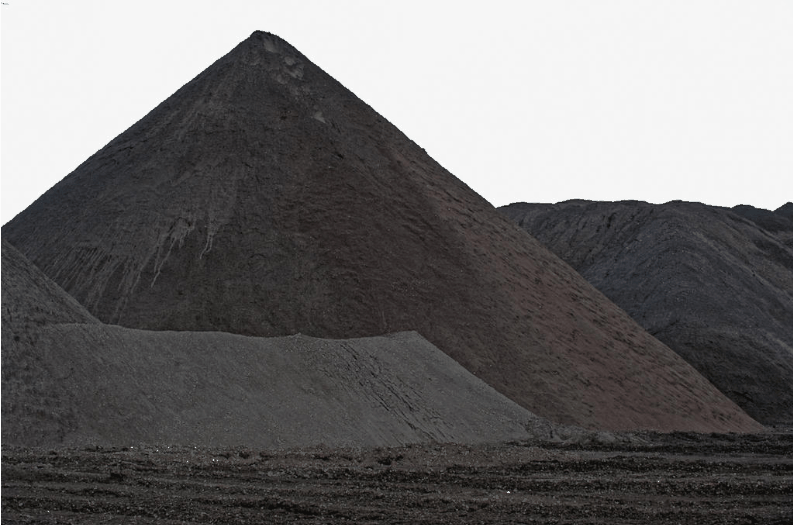


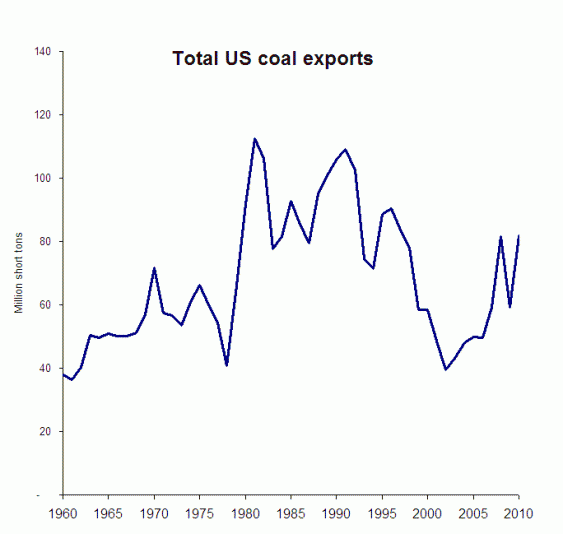

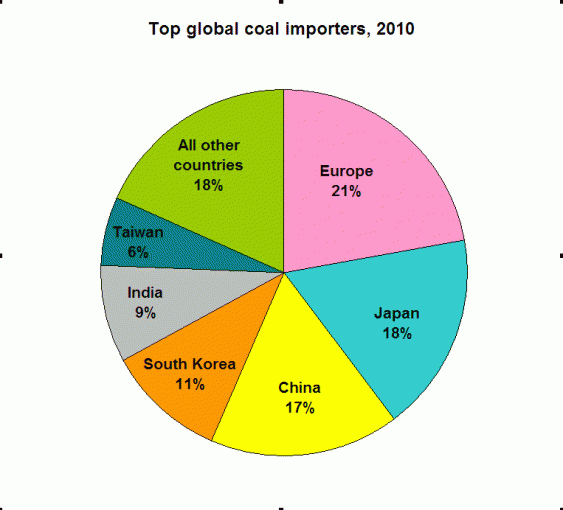
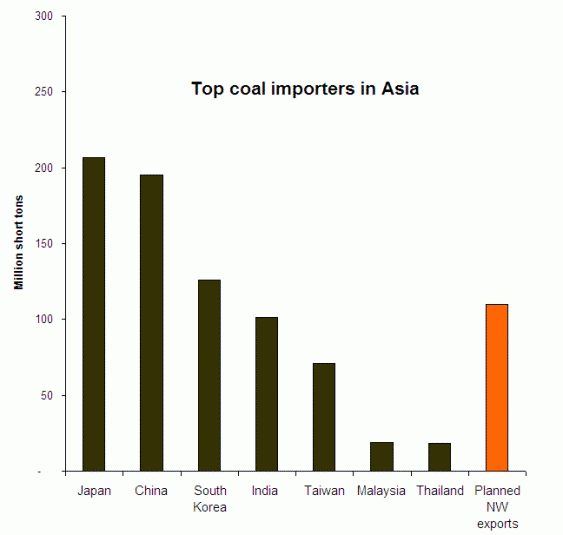
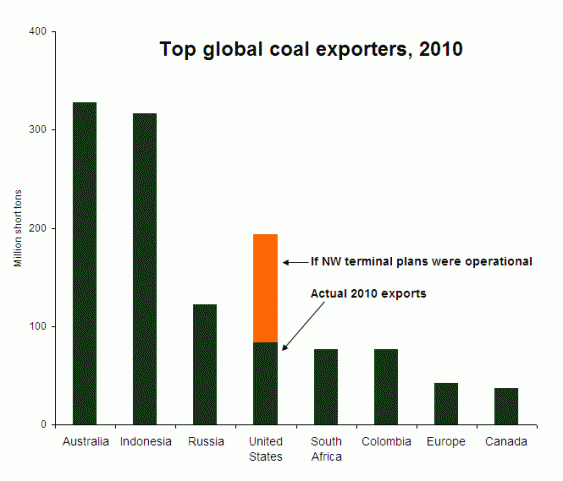
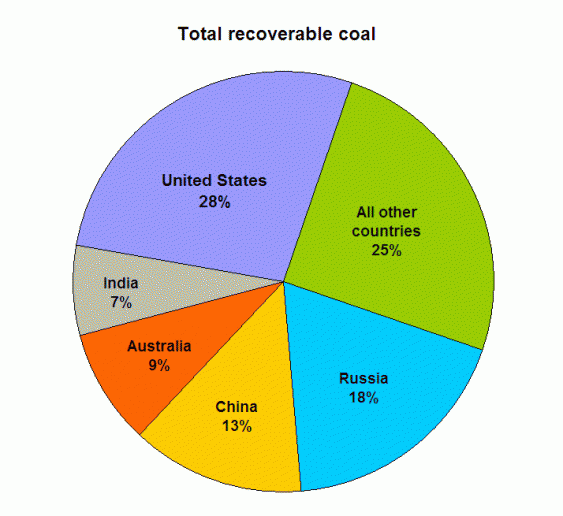
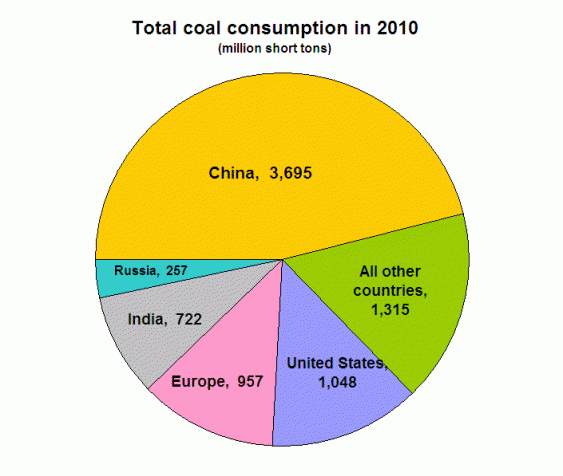







canyonguy26
I like this one… good info.
A couple of important items that I did not notice mentioned. Your export numbers are based off full export capacity. Example, Norfolk and Baltimore hardly ever have historically run at full capacity so I think this is at least worth noting. Also, when you compared “full tonnage export capacity” to other countries, you did not mention the fact that the competition from the PRB could lower the out-put of some of the other nations mines.
Eric de Place
Thanks.
But I don’t follow you. My figures aren’t based on calculating export capacity; I’m just reporting the actual export volumes published by EIA. I would assume that 2010 does not represent full use of US export capacity since 20 years ago total export volumes actually used to be higher than they are now.
Bryan
Eric very good piece.. I agree with Jason on the numbers, I doubt that either Longview or Cherry Point will ever export the tonnage that is being proposed, but your point is well taken. By your own numbers though, the arguements that jason and I have been making is that if coal isn’t exported from the states, coal will still be burned.
canyonguy26
I should have said, your export “graph” is based on maximum capacity if the Longview and Cherry Point Facility were built and run at full tilt.
I still liked the blog… Good job.
Erin
While potential Washington exports are the focus of this project (and of major importance), don’t forget that most of that “total recoverable coal” in the US is in Alaska.
Alaska has had little coal mining to date, but the dynamics of the Asian marked could change this quickly. A number of large and controversial coal mine proposals on the table right now, and the vast majority of any coal extracted would be shipped to Asia (Alaska consumes very little coal in state). The largest current proposal is 12 million metric tons/year, but the potential is much greater.
For climate change, it’s a huge potential issue.
The nonprofit I work with has developed an extensive set of articles and analyses on Alaska coal, if anyone wants to learn more.
canyonguy26
I have seen something in these analysis of future output… What competition will do to other international mines. Especially, where better quality coal with a comparable price comes into play.
canyonguy26
Typo…. Something that I have not seen in the analysis of future output…….
Liz
Eric, this provides excellent national and international context. A great summation. Thank you!
Zane Selvans
It’s worth noting that the EIA makes no effort to ascertain the economic recoverability of US coal reserves. The often quoted “250 years” of reserves (which I suspect is the number which went into your global coal reserves pie chart) is only a statement of what we could, technically, dig out of the ground if cost were no object. The USGS, on the other hand, has been doing analyses of the economic recoverability of US coal reserves, and they paint a pretty different picture. The overwhelming majority of our economically recoverable reserves are in the Powder River Basin, and that coal is going to get more difficult/expensive to extract over time as we have to dig deeper and deeper to get at it. How much is available depends on how much you’re willing to pay. Check out The 2009 National Coal Resource Assessment, especially Chapter D [PDF], which looks at overall economically recoverable reserves in all major US coal fields. For more detail on the behemoth — Powder River — see OFR 2008-1202. Figure 66 (depicting production cost vs. amount of coal produced) is particularly interesting.
Neal Jacques, P.E.
Happy to find the article above. I am preparing a talk for our local chapter of Washington Society of Professional Engineers to be presented in early January 2012. Will be visiting Longview right after xmas to talk with the planners and would be interested in any source help. I have extensive experience with constructing coal terminals so have a realistic background.
Steve Harrell
Love those charts; will make a .pdf of this for my Environment and Society in China class next time I teach it. When you say that “energy policy decisions in China will drive demand,” this might be deceptive. Right now, about 71% of China’s total energy use (for all purposes, not just power generation) comes from coal, and the announced goal is to reduce that to 60% in the next couple of decades. But it will be 60% of a larger total energy consumption, so the absolute amount of coal that China consumes is still expected to grow, despite the fact that China is putting great efforts into diversifying. So I think the bottom line is that China’s demand is not about to go down, no matter how hard they try. Which might mean that Cherry Point and Longview could indeed operate at full capacity as long as the Powder River can feed them. If you want to learn more about coal in China, I highly recommend the China FAQswebsite produced by the World Resources Institute.
jason kinney
how long do you think ill have a job in the coal mine meaning do you yhink it will be a while